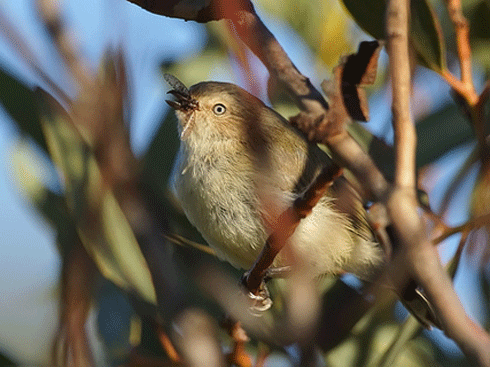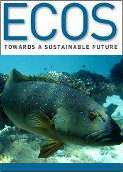
|
Published: 12 June 2012
Australia’s tiniest bird benefits from revegetation of farmland
Well-planned revegetation on farms in southern Australia is leading to marked recovery in native woodland bird populations a major study has found – and one of the main beneficiaries is the weebill, Australia’s tiniest bird.

|
|
A weebill (Smicrornis brevirostris), South Australia. The weebill is Australia’s smallest bird (8-9cm). Well planned on-farm revegetation can increase numbers of this bird. Credit: David Cook Wildlife Photography. Rights: Licensed under a Creative Commons Attribution Non-Commercial License
|
The study, published in the journal Biological Conservation, found strong evidence in a five-year study that revegetation programs can have a strongly beneficial effect on both woodland bird numbers and mix of species.
‘It sounds absolutely obvious, that if you increase native vegetation you get more birds – but, surprisingly, worldwide there is very little hard evidence to show what impacts the billions of dollars spent on landscape restoration are having,’ says Professor David Lindenmayer of CEED and the Australian National University.
‘This, to our knowledge, is the first study to show an unequivocal return on the major investment made by Australian taxpayers in tree planting and revegetation on farms – in terms of birdlife returning to agricultural landscapes.’
Prof. Lindenmayer and his team studied bird populations at over a hundred sites in the Murray Catchment Management Authority region around Deniliquin, Urana and Jerilderie in NSW, noting a progressive increase in both numbers and variety of woodland birds in land as it was re-covered with native trees and shrubs.
‘At one end of the scale we have the open agricultural landscapes, which are dominated by the large seed-eating birds like cockatoos, galahs and parrots and at the other, the travelling stock reserves, which are about as close as you can get to a natural native landscape, where woodland species abound,’ he explains.
‘When we compared these with land that had been revegetated in the last couple of years and land which was revegetated 7 or more years ago, we found a progressive improvement in both numbers and assemblages of woodland birds as native trees and shrubs recovered.
‘Put simply, after about 8 years, you can expect to get around 25% of your woodland birds back. More importantly, these include the smaller species and those which are of greatest conservation concern.’
The recovering species include birds such as the speckled warbler, the chestnut-rumped thornbill, the crested shrike-tit and the tiny 8cm weebill, named after its characteristic ‘wee-bill’ call.
Prof. Lindenmayer describes the survey work as as painstaking’, involving covering large distance on foot ‘being chased by bulls’, year after year.
‘But now we know for sure that conservation pays. With the right sort of revegetation plan, you can be confident that many native species will recover.
‘It tells us that Australian can invest more in conservation, and be confident of getting a good outcome,’ says Prof. Lindenmayer.
New research is showing that increasing the area of a property under native vegetation from as little as 4% to 8% can provide a huge boost to biodiversity.
‘The message is that many of Australia’s birds are on the way back in these tiny areas where the landscape has been restored. This reinforces the argument that we should invest more, as a country and as individuals, in recovering our native species – because we know it works.’
Source: Australian Research Council Centre of Excellence for Environmental Decisions (CEED)



